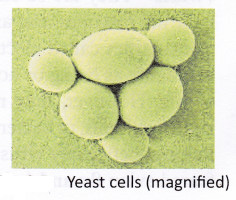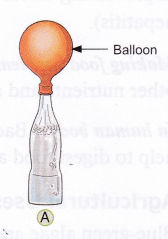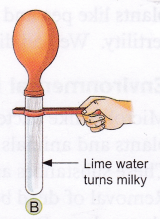What Are The Uses Of Microorganisms In Our Daily Life
Uses Of Microorganisms In Our Daily Life
Microorganisms benefit us in a number of ways. Their uses can be divided into four categories: commercial, medicinal, agricultural, and environmental. Let us discuss each of these in detail.
Commercial Uses of Microorganisms
Some of the commercial uses of microorganisms are given below.
Making curd and cheese: Do you know how curd is made at home? Usually, a spoonful of curd is added to warm milk, which turns into curd overnight. This happens because a protein called casein present in milk coagulates to form curd. For casein to coagulate, the milk has to be made acidic. A bacterium called Lactobacillus, present in the spoonful of curd added to the milk, converts the lactose sugar present in milk to lactic acid. This creates the acidic environment needed for casein coagulation. The process of conversion of a sugar into an acid or an alcohol by the action of microorganisms is called fermentation.
Activity
Aim: To prepare curd.
Materials needed: Milk (one glass), a teaspoon of curd, a bowl, and a lid.
Method:
1. Ask an adult to warm the milk.
2. Transfer the milk to the bowl and add a spoonful of curd to it. Stir well and cover the bowl with a lid. Leave the bowl undisturbed overnight.
Observation: The milk has transformed into curd.
Conclusion: The bacterium Lactobacillus present in the spoonful of curd added to the milk converts milk into curd.
Note: Adult supervision required.
The production of cheese and paneer (cottage cheese) also involves the use of bacteria like Lactobacillus and Streptococcus. Curd and cheese manufacturers also add a substance called rennet (usually obtained from stomach linings of young cattle) to milk to make the process faster. Addition of rennet results in the formation of lactic acid, which makes the milk more acidic.

Making alcoholic beverages: Production of alcoholic beverages like beer and wine involves fermentation of sugar present in barley and grapes, etc., by a microscopic fungus called yeast. Fermentation by yeast produces alcohol and carbon dioxide.
Making bread: The process of making bread involves kneading a mixture of flour, salt, sugar, yeast cells, and water into dough. Yeast converts sugar to alcohol and carbon dioxide. As more and more carbon dioxide is produced, the dough rises in volume. This makes the bread porous and spongy. Baking the expanded dough at 180°C kills the yeast and stops fermentation. The alcohol evaporates during the baking process.
Activity
Aim: To observe fermentation of sugar by yeast cells.
Materials needed: Sugar (two tablespoons), warm water (1 cup), a balloon, empty plastic bottle (1 litre), and active yeast cells.
Method:
-
- Stretch the balloon by blowing it up and deflating it a few times. Keep it aside.
- Add sugar and yeast cells to the cup of warm water and mix thoroughly.
- Pour the mixture into the bottle. Attach the balloon to the mouth of the bottle (see figure A) and leave it undisturbed.

Observation: The volume of the mixture inside the bottle increases.
The balloon inflates and you can smell alcohol in the mixture inside the bottle. If you pass the gas filled inside the balloon through a test tube containing lime water, the lime water will turn milky (figure B). This proves that the gas released is carbon dioxide.
 Conclusion: Fermentation of sugar by yeast produces alcohol and carbon dioxide. As carbon dioxide rises up, we observe an increase in the volume.
Conclusion: Fermentation of sugar by yeast produces alcohol and carbon dioxide. As carbon dioxide rises up, we observe an increase in the volume.
Making vinegar, coffee, and tobacco: Bacteria are used in the production of vinegar (acetic acid), coffee, and tobacco.
Making toothpaste: Shells of diatoms (a type of algae) are used in toothpaste to give it a gritty texture that helps in cleaning teeth. Xanthum gum, obtained from the bacteria Xanthomonas campestris, is also used in making toothpaste.
Medicinal Uses of Microorganisms
Some of the medicinal uses of microorganisms are given below.
- Making antibiotics: Certain bacteria and fungi are used in the production of medicines called antibiotics that destroy certain disease-causing microbes. Penicillin (obtained from the fungus Penicillium), streptomycin, and tetracycline (both obtained from Streptomyces bacteria) are examples of antibiotics. Antibiotics are also used to control microbial diseases in animals and plants.
- Making vaccines: When a disease-causing microbe enters our body, our body produces substances called antibodies. These antibodies fight and destroy the disease-causing microbe and remain in the body to fight future infections by the same microbe. A vaccine is a preparation of killed or weakened disease-causing microbes. When a vaccine is introduced in the body of a healthy person (by swallowing or injection), his/her body produces antibodies against these killed or weakened microbes. These antibodies remain in the body and protect us from future infections by the same microbe(s). Thus, vaccines help in preventing diseases caused by microbes (e.g., polio, cholera, typhoid, smallpox, and hepatitis).
- Making food supplements: Microbes like Chlorella (a type of algae) are rich in proteins and other nutrients and are used as food supplements.
- In human body: Bacteria like Lactobacillus acidophilus live in human intestines, where they help to digest food and destroy disease-causing microbes.
Agricultural Uses of Microorganisms
Blue-green algae and bacteria like Rhizobium (that live in the root nodules of leguminous plants like pea and soya bean) help in fixing atmospheric nitrogen and increasing soil fertility.
Environmental Uses of Microorganisms
Microbes like bacteria and fungi act on the bodies of dead plants and animals and convert them into simple substances. These substances are used by other plants and animals. Removal of dead bodies by the action of microbes keeps our planet clean. Bacteria are also used in sewage treatment, where waste organic matter.
The post What Are The Uses Of Microorganisms In Our Daily Life appeared first on A Plus Topper.
from A Plus Topper
via Learning Made Simple 360
*Note that these contents are Autoblogged from A Plus Topper and cannot be edited.
Join the conversation